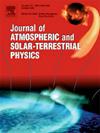Pre-seismic ionospheric disturbances (PIDs) associated With 2021 Mw 7.5 Northern Peru earthquake: GNSS and ground uplift observations
IF 1.9
4区 地球科学
Q3 GEOCHEMISTRY & GEOPHYSICS
Journal of Atmospheric and Solar-Terrestrial Physics
Pub Date : 2025-09-27
DOI:10.1016/j.jastp.2025.106644
引用次数: 0
Abstract
Predicting natural disasters such as earthquakes remains a major challenge in geosciences, with critical implications for early warning systems and disaster risk reduction. Among various precursory signals, ionospheric anomalies have gained increasing attention as potential indicators of impending seismic events. In this study, we examine pre-seismic ionospheric disturbances (PIDs) associated with the Mw 7.5 Northern Peru earthquake on November 28, 2021, using Global Navigation Satellite System (GNSS) Total Electron Content (TEC) and ground vertical velocity data. Significant sequential negative TEC anomalies were observed up to two hours prior to the mainshock, with multiple disturbances recorded by several GNSS receivers. The amplitudes of these disturbances increased as the earthquake approached, suggesting a progressive ionospheric response to the buildup of tectonic stress. Spectral analysis using the Short-Time Fourier Transform revealed center frequencies between 3.63 mHz and 4.80 mHz — within the acoustic/infrasonic range — indicating that such waves, possibly generated by foreshocks, may be responsible for these PIDs. To rule out other sources of TEC anomalies, we examined the TEC data for the previous day along the same trajectories and found no similar disturbances. Furthermore, geomagnetic conditions were quiet during the period, as indicated by Kp and Dst indexes two days before and after the earthquake. These findings contribute to the understanding of seismo-ionospheric coupling and highlight the potential role of ionospheric monitoring as a complementary approach to conventional seismic methods in earthquake early warning systems.
与2021 Mw 7.5秘鲁北部地震相关的震前电离层扰动(PIDs): GNSS和地面隆起观测
预测地震等自然灾害仍然是地球科学的一项重大挑战,对早期预警系统和减少灾害风险具有重要意义。在各种前兆信号中,电离层异常作为即将发生的地震事件的潜在指标而受到越来越多的关注。在这项研究中,我们使用全球导航卫星系统(GNSS)总电子含量(TEC)和地面垂直速度数据,研究了与2021年11月28日秘鲁北部7.5 Mw地震相关的震前电离层扰动(ids)。在主震发生前两小时,观测到明显的连续负TEC异常,几个GNSS接收器记录了多次干扰。这些扰动的振幅随着地震的临近而增加,这表明电离层对构造应力的积累有一个渐进的反应。使用短时傅立叶变换的频谱分析显示,中心频率在3.63 mHz和4.80 mHz之间,在声学/次声范围内,表明这种可能由前震产生的波可能是这些PIDs的原因。为了排除TEC异常的其他来源,我们沿着相同的轨迹检查了前一天的TEC数据,没有发现类似的干扰。从地震前后两天的Kp和Dst指数可以看出,这一时期的地磁条件是安静的。这些发现有助于理解地震-电离层耦合,并突出了电离层监测作为地震预警系统中常规地震方法的补充方法的潜在作用。
本文章由计算机程序翻译,如有差异,请以英文原文为准。
求助全文
约1分钟内获得全文
求助全文
来源期刊

Journal of Atmospheric and Solar-Terrestrial Physics
地学-地球化学与地球物理
CiteScore
4.10
自引率
5.30%
发文量
95
审稿时长
6 months
期刊介绍:
The Journal of Atmospheric and Solar-Terrestrial Physics (JASTP) is an international journal concerned with the inter-disciplinary science of the Earth''s atmospheric and space environment, especially the highly varied and highly variable physical phenomena that occur in this natural laboratory and the processes that couple them.
The journal covers the physical processes operating in the troposphere, stratosphere, mesosphere, thermosphere, ionosphere, magnetosphere, the Sun, interplanetary medium, and heliosphere. Phenomena occurring in other "spheres", solar influences on climate, and supporting laboratory measurements are also considered. The journal deals especially with the coupling between the different regions.
Solar flares, coronal mass ejections, and other energetic events on the Sun create interesting and important perturbations in the near-Earth space environment. The physics of such "space weather" is central to the Journal of Atmospheric and Solar-Terrestrial Physics and the journal welcomes papers that lead in the direction of a predictive understanding of the coupled system. Regarding the upper atmosphere, the subjects of aeronomy, geomagnetism and geoelectricity, auroral phenomena, radio wave propagation, and plasma instabilities, are examples within the broad field of solar-terrestrial physics which emphasise the energy exchange between the solar wind, the magnetospheric and ionospheric plasmas, and the neutral gas. In the lower atmosphere, topics covered range from mesoscale to global scale dynamics, to atmospheric electricity, lightning and its effects, and to anthropogenic changes.
 求助内容:
求助内容: 应助结果提醒方式:
应助结果提醒方式:


